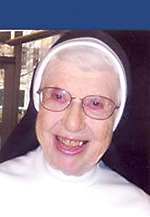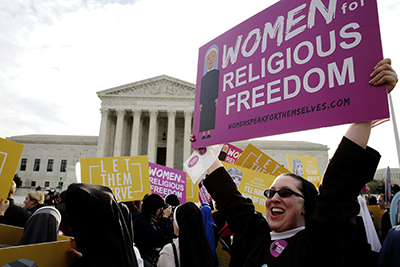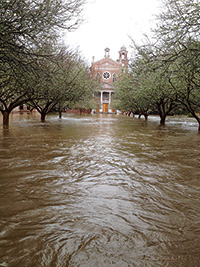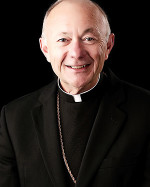By Peter Finney Jr.
NEW ORLEANS (CNS) – The idea of making a walking pilgrimage in the United States took root about four years ago when Dominican Fathers Francis Orozco and Thomas Schaefgen were studying together for the priesthood.
They saw the movie, “The Way,” featuring Martin Sheen, who portrayed a father honoring his late son’s memory by completing the 450-mile Camino de Santiago, the “Way of St. James,” a pilgrimage route across Spain taken for centuries by pilgrims.
“We had both studied abroad in Spain, but we thought, why don’t we do something more local, something in this country?” said Father Orozco, chaplain of the Catholic Student Center at Texas Tech University in Lubbock. “We looked up places, and there really weren’t any established pilgrimages in the U.S., so we said, ‘Let’s make up our own.’”
From that seed sprouted “Friars on Foot,” a 478-mile pilgrimage on foot from New Orleans to Memphis, Tennessee, which will begin after the 11 a.m. Mass at St. Anthony of Padua Church in New Orleans May 29 and arrive in Memphis June 29.
Folks can follow the two young friars and their travels at the website friarsonfoot.wordpress.com.
Father Orozco, 33, and Father Schaefgen, 32, who is director of the Catholic Student Center at Tulane University, will wear their white Dominican habits and take small backpacks with water and other essentials such as sunscreen, but they will carry no money or cellphones.
“We want to do this very minimally,” Father Orozco told the Clarion Herald, newspaper of the Archdiocese of New Orleans. “We will not carry any money and we will sort of beg. We hope people will provide us with apples and granola bars. We don’t plan to use any money. We will carry ID cards and medical insurance cards in case that’s needed. We’ve compromised with our superior that we will have somebody update the website every time we reach a destination.”
The friars plan to stay overnight at Catholic churches or with Catholic families along the way, celebrating Mass and even giving history and vocation talks about the 800-year-old congregation – the Order of Preachers – whose earliest members were itinerant preachers, walking from town to town.
They will average about 16 miles a day. There are only two stops in Mississippi without Catholic churches – Pickens and West – and on those nights they probably will stay at a local Protestant church.
The friars are encouraging people to join them on the walk, if only for an hour or two.
“We will have a pilgrim rule, and part of it will be to the pray the rosary and the Liturgy of the Hours every day, but that won’t take up the entire time,” Father Orozco said. “If there are people with us, we can talk about whatever they would like to talk about.”
Since walking along interstate highways is prohibited, the Dominicans will take local and state highways. The pilgrimage route will basically track Highway 51 north to Memphis.
The pilgrimage will conclude June 29 at St. Peter Church in Memphis, the National Shrine of St. Martin de Porres.
So what do their families and their fellow friars think?
“As we progressed, the first reaction was the question ‘why’?” Father Orozco admitted. “Then it was just a matter of explaining. In many ways, I’m glad it’s taken four years to plan it because it gave them time to soften up to the idea. We presented this to the province a couple of years ago, and I think the vague response was, ‘These are young guys. Once they’re ordained priests they’ll forget about it.’”
Surprise.
“I bet some of the friars forgot about it,” Father Orozco said. “Some said, ‘I guess they’re really going.’ I had one student tell me, ‘You know, it’s very humid in Mississippi, right?’ By and large, 99 percent are excited about it.”
(Finney is executive editor/general manager of the Clarion Herald, newspaper of the Archdiocese of New Orleans.)
Category Archives: U.S. News
Jackson vocations office, New Orleans seminary both add staff
JACKSON – In February of this year Bishop Joseph Kopacz reorganized the Office of Vocations, forming a team to promote religious vocations within and outside the Diocese of Jackson. The office now has three employees, Father José de Jesús Sánchez acts as the director of recruitment, Father Brian Kaskie is the director of seminarians and Melisa Preuss-Muñoz is an administrative assistant.
Father Sánchez’s ministry is to travel throughout the diocese visiting Catholic high schools, parishes and colleges, to promote the priesthood as an option for young men, and religious life for both men and women. These visits provide Father Sánchez with the opportunity to discuss what it means to hear and follow God’s call.
Meeting with young adults enables him to discern who, among these young people, shows the interest and skills to enter into the religious life. He also continues to serve as associate pastor for the Catholic Community of Meridian.
In addition, Father Sánchez makes himself available to counsel those who find it difficult to hear God’s call, whether it be to the priesthood, religious life, marriage or single life. He commits himself to meet with the young people to talk about their dreams and God’s dreams for them. The end goal is to give young adults the means to evaluate themselves and God’s desires for them, so that they may reach holiness and help others to become holy as well.
Finally, if a young man decides to begin his priestly formation or a young woman, the religious life, Father Sánchez will help them apply to the seminary or religious community.
Father Brian Kaskie, director of seminarians, walks closely with those who are in seminary formation either at St. Joseph Seminary College in St. Benedict, La., where men pursue a college degree while going through initial discernment and at Notre Dame Seminary in New Orleans for graduate studies and final formation. Father Kaskie keeps in constant communication with the seminarians and helps to provide everything they might need during their years of discernment and formation. He attends their evaluations and acts as a liaison between the seminary and Bishop Kopacz. He is also pastor of McComb St. Alphonsus Parish.
Melisa Preuss-Muñoz acts as a link between Father Sanchez, Father Kaskie, and the seminarians. She works in the chancery in Jackson. Her duties also include updating the vocations section of the website for the Diocese of Jackson, developing and distributing diocesan resources for religious vocations, and organizing and implementing various activities, such as Vocation Awareness Days, at schools.
“We are eager to answer any questions you may have about religious life and would like to help you in any possible. God calls us to the religious life in mysterious ways. If you feel you might hear the call or if you would like to speak with Father Sánchez about discerning God’s call, please call the office,” said Preuss-Muñoz.
Anyone can reach the Religious Vocations office by phone at 601-960-8484 or email at vocations@jacksondiocese.org. Anyone can support the efforts to promote vocations by prayer and on social media by following Jackson Vocations on Facebook, Twitter (@jxnvocations), and the website (vocations.jacksondiocese.org).
Sister Josephine Uhll dies
SPRINGFIELD, Ill. – A Mass of Christian Burial for Sister Josephine Therese

Uhll
was celebrated Tuesday, April 12, at Sacred Heart Convent in Springfield. Sister Uhll died on April 9. Her legacy of service is the 40 years she gave to healthcare administration at St. Dominic Health Services in Jackson.
She retired in 1995 from her role as president and board chair, having overseen the growth of St. Dominic’s from a small hospital to a multi-institutional health system that remains today the only Catholic health system in Mississippi. One of her most cherished accomplishments was the development of St. Catherine’s Village, a life care retirement facility in Madison.
A memorial service to honor the life of Sister Uhll will be held at the St. Dominic Chapel in Jackson Tuesday, April 26, at 7 p.m.
She was born in Morrisonville, Ill., in 1918. Her earliest years of religious life were spent in elementary school education in Illinois and Minnesota. She made her profession of vows in 1937 at Sacred Heart Convent, Springfield.
Sister Uhll was a Fellow of the American College of Healthcare Executives. Sister Josephine Therese was preceded in death by her parents, sister Mary Jo Figueira and brothers Roy B., and James D. Uhll. She is survived by her Dominican Sisters; nephews James D. (Mary Ann) Uhll, David (Dena) Uhll, Robert (Debbie) Uhll, Thomas (Shirley) Uhll, and nieces Nancy Hay, Barbara (Connie Joe) Mason, and Sharon Therese (Joe) Bencze.
In lieu of flowers, memorials may be made to the St. Catherine’s Village Dominican Fund, 200 Dominican Drive, Madison, MS 39110 or Dominican Sisters Retirement Fund, 1237 W. Monroe St., Springfield, IL 62704.
Year of Mercy: Ministry of Mercy tackles suicide epidemic
ROSEBUD, S.D. (CNS) – A sad reality on a number of Native American reservations is the high suicide rate. That is especially true on the Rosebud Reservation in south central South Dakota.
In 2007 – at the height of an ongoing suicide epidemic – the number of deaths by suicide on Rosebud was roughly 13 times the national average, making it, according to one report, the highest in the world.
To help address this crisis, St. Francis Mission, a Jesuit ministry on this Lakota reservation, has started a suicide and crisis hotline.
For Geraldine Provencial, its director, her work has a strong personal motivation: “What inspires me to work with the suicide and crisis hotline is the experience I have had with suicides in my own immediate family. I lost a sister to suicide, a brother to suicide and my grandson’s mother to suicide, which has resulted in my taking care of my grandson today, who is 11 years old. He is my inspiration.”
Not having had support when she herself had to deal with these suicides is what spurs Provencial today to reach out to others on the reservation who are experiencing these difficulties.
“To work with this type of program takes courage because there is a lot of sadness that is part of the suicide crisis,” she told Catholic Extension magazine. “The hurt and pain that people are carrying within themselves does not go away when they take their lives. The pain just gets passed on to us family members, and we feel that for the rest of our lives.”
She relies on her faith to carry her through and help her find hope, so that, in turn, she can help others and “be there for them when those kinds of thoughts cross their minds.” She also has found that “faith is a huge piece in people’s recovery and helps them to find what they are seeking. The Catholic faith can give a person something they can lean on to find direction in their lives and better their lives.”
On the 24/7 hotline, she and her trained volunteers talk both with individuals who are contemplating suicide and with family members concerned that someone may be thinking about ending his or her life. “The hotline is providing that last grasp of hope. Some of the individuals will ask for prayers for strength to help them get through their most difficult time, which is part of the reason why they reach out to us.”
In emergency situations, “the main priority is to keep the person on the line and talking. This could mean being on the phone for a couple of hours,” she said. The responders work to identify the caller’s location and to get the tribal police to get him or her to the local Indian Health Services emergency room for mental health and support services.
“When people in crisis call,” Provencial said, “we never know what type of call it is going to be. Some of the callers just need someone to listen to them.”
Provencial also directs the Icimani Ya Waste’ (Lakota for “Good journey”) Recovery Center, where she facilitates a monthly, four-day program to tackle the family dynamics involved in addiction and holds recovery-related meetings and 12-step programs.
Drug and alcohol abuse, 10 times the national rate, is a major contributing factor to the reservation’s high suicide rate, and both are rooted in a larger bleak socioeconomic reality. The Rosebud Reservation has one of the highest unemployment rates in the country – about 83 percent – and Todd County, where Rosebud is located, is the third poorest county in the United States. Domestic violence, sexual assault and gang violence also have been identified as major factors contributing to despair and suicide on the reservation.
Provencial is part of the first group of people whose salary Chicago-based Catholic Extension is helping to pay through a new Health Ministry Salary Subsidy Initiative. Started last fall, the initiative was made possible by an anonymous gift from a foundation.
Catholic Extension, an organization that supports the work and ministries of U.S. mission dioceses, has had a long-standing relationship with St. Francis Mission, going back to helping build the mission in 1910.
According to its president, Jesuit Father John Hatcher, the mission’s strong focus on healing ministries has come from asking the question, “Where are people hurting, and how can the church minister to them?” Addressing alcoholism and the suicide epidemic are top priorities.
“Through the hotline, we’ve been able to intervene with people who are in extreme danger of killing or hurting themselves or being hurt by someone else,” Father Hatcher said. “Once we’ve sent out emergency vehicles, we can follow up with them and continue the healing.”
(Editors Note: This article is one in a series by Catholic Extension to highlight some of the many corporal and spiritual works of mercy carried out in U.S. mission dioceses during the church’s Jubilee Year of Mercy.)
Mother Angelica, EWTN founder, evangelist, dies
Irondale, AL (EWTN) – Mother Mary Angelica of the Annunciation, P.C.P.A., known to millions around the world as Foundress of the EWTN Global Catholic  Network, died peacefully at 5 p.m., Easter Sunday, March 27, surrounded by the Poor Clare Nuns of Perpetual Adoration of Our Lady of the Angels Monastery in Hanceville, Ala.
Network, died peacefully at 5 p.m., Easter Sunday, March 27, surrounded by the Poor Clare Nuns of Perpetual Adoration of Our Lady of the Angels Monastery in Hanceville, Ala.
Known commonly as Mother Angelica, the nun started the network with $200 and no experience in television. It grew to be the largest Catholic media network in the world. Mother Angelica suffered a stroke in 2009, leaving her unable to speak. Her final years were spent in prayer with her fellow Poor Clares. A Mass of Christian Burial was set for Friday, April 1, at 11 a.m. at the Shrine of the Most Blessed Sacrament in Hanceville.
Supreme Court hears oral arguments in HHS mandate case
By Carol Zimmermann
WASHINGTON (CNS) – During oral arguments March 23 at the Supreme Court, attorneys on both sides of the Affordable Care Act’s contraceptive requirement examined how the mandate either violates or strikes a balance with religious freedom.
Lawyers representing the seven groups of plaintiffs said the federal government’s so-called accommodation for religious employers to arrange for a third party to provide contraceptive coverage in health plans was inconsistent because the government already had been able to provide churches an exemption from the requirement.

Women religious lobby against the Affordable Care Act’s contraceptive mandate March 23 on the steps of the U.S. Supreme Court ahead of oral arguments in Zubik v. Burwell in Washington. (CNS photo/Jim Lo Scalzo, EPA)
Paul Clement of the Washington-based Bancroft firm, who was one of two lawyers representing the plaintiffs, argued that religious freedom was at stake in the federal government’s accommodation because even though the contraceptive coverage would be supplied by a third party, the religious employers would still be complicit in providing something that goes against their beliefs.
“The problem is we have to fill out a form, and the consequence of us filling out that form is we will be treated very differently from those other religious employers” that are exempt, he said.
U.S. Solicitor General Donald Beaton Verrilli Jr., in defending the federal government, argued that the government’s accommodation struck the necessary balance required by the Religious Freedom Restoration Act of 1993.
RFRA says that if a law restricts the free exercise of religion guaranteed by the Constitution, there must be a compelling government interest to do so and it must not place an unreasonable burden on the religious exercise.
Justice Ruth Bader Ginsburg stressed that “no one doubts for a moment the sincerity” of the religious employers that object to providing contraceptive health care coverage, but she and other justices indicated that such a belief goes up against the compelling interest of the government’s plan to provide health coverage for women, and the accommodation sought to find that balance.
Clement argued that an accommodation isn’t “immune from RFRA analysis” and that the problem is giving an accommodation to some religious groups, but not all.
Noel Francisco of Jones Day, arguing on behalf of the dioceses who are plaintiffs, also noted that if the government is willing to address the contraceptive coverage in some ways for groups that meet the accommodation standard, than they should look to other ways for other religious groups to be exempt as well.
There was a fair amount of back and forth on where the government should draw the line and if it draws it one place, should it draw it again, or should it never have drawn the line in the first place?
Verrilli said the government’s line has not always been perfect, but it did try to try to strike a balance. There is an objective limit to what RFRA can do, he added.
He said the government’s solution was the least restrictive approach, and he also did not think the plaintiffs, by using third parties, were complicit in what they disagreed with, even though they have stated again and again they feel that way.
As the discussion centered on health exchanges, grandfathered clauses and exemptions, Chief Justice John Roberts summed up the argument with Verrilli as the government’s desire for a “seamless” health care package versus the religious objections of the plaintiffs.
The Little Sisters of the Poor, Priests for Life and the dioceses of Pittsburgh and Erie, Pennsylvania, and the Archdiocese of Washington are among numerous plaintiffs around the country consolidated into Zubik v. Burwell.
The case is named for Pittsburgh Bishop David Zubik and Sylvia Mathews Burwell, the current secretary of the Department of Health and Human Services.
Under the Affordable Care Act of 2010, most religious and other employers are required to cover contraceptives, sterilization and abortifacients through employer-provided health insurance. Refusal to comply subjects nonexempt employers to heavy fines.
A very narrow exemption for churches and religious orders was permitted from the start, but several Catholic and other religious institutions and ministries that were not exempted – such as colleges, hospitals and charitable providers – said they could not participate in providing contraceptives without violating their beliefs.
The Obama administration then created its accommodation, or “work-around,” that allows objecting employers to acknowledge their opposition to the contraceptive coverage by notifying HHS in a letter. This triggers an arrangement for a third party to provide the coverage. These employers still found the “opt-out” provision objectionable.
Five years later, several circuit courts of appeal ruled that religious entities, such as the Denver-based Little Sisters of the Poor, were not substantially burdened by the opt-out procedures. Only one such court, the 8th U.S. Circuit Court of Appeals, in a September ruling, accepted the nonprofits’ argument that complying with the opt-out provision violates their religious beliefs.
In the 2014 Hobby Lobby case, the Supreme Court relied on RFRA to rule in favor of two family-owned private businesses, Hobby Lobby Stores and Conestoga Wood Specialties, who argued that providing contraceptives in health care coverage to employees was contrary to the owners’ Christian beliefs.
(Follow Zimmermann on Twitter: @carolmaczim.)
(Copyright © 2016 Catholic News Service/United States Conference of Catholic Bishops. The CNS news services may not be published, broadcast, rewritten or otherwise distributed, including but not limited to, such means as framing or any other digital copying or distribution method in whole or in part, without prior written authority of Catholic News Service.)
St. Joseph Abbey seeks recovery help
COVINGTON – In Louisiana, the Northshore was hard hit. St. Joseph’s Abbey had to cancel Abbey Fest, their annual youth gathering in anticipation of storms. A day later, almost every building at the abbey took more than two feet of water. The monks and the almost 140 seminarians were trapped by the quickly-rising floodwaters and had to spend one night on the second floor of whatever building they were in. No one was hurt, but the Abbey had no flood insurance.

A photo from Friday, March 11, shows water creeping up the steps of the church at St. Joseph’s abbey. The water has dropped, but damage remains. (Photo courtey of Rhonda Bowden)
“Almost every building on St. Joseph Abbey and Seminary College campus was inundated with about two feet of water, including the classrooms, residence hall, library, woodworks, gift shop, monastery, monastery refectory, and the basement of the Abbey church, which houses all the electrical work and air conditioning equipment. It’s going to be a long recovery. The outpouring of support from the community has been overwhelming,” said Abbot Justin Brown, OSB.
Photos posted on social media also showed most of the cars flooded as well. This flood was the worst in the seminary’s history, topping the 1927 flood by several inches.
Three men from the Diocese of Jackson are studying at St. Joseph’s this year. The seminary is accepting donations on its website, https://www.saintjosephabbey.com/donate.
Little Sisters of the Poor become face of HHS opposition
WASHINGTON (CNS) – Visuals often are much easier to grasp than a complicated thicket of issues. That may be why the Little Sisters of the Poor have become the public face of Zubik v. Burwell, which goes before the U.S. Supreme Court March 23.
Zubik is not just about the religious order’s legal challenge of the Obama administration’s contraceptive mandate for employers. It is a consolidated case also involving East Texas Baptist University, Southern Nazarene University and Geneva College, which is a Presbyterian institution, as well as Catholic entities, including the Archdiocese of Washington, the dioceses of Pittsburgh and Erie, Pennsylvania, and Priests for Life.
Both sides on the mandate issue have been working to attract public support. The Little Sisters, like Priests for Life, have launched a website explaining their side of the issue, and of any of the cases the Little Sisters suit has received the most attention, media and otherwise. They are receiving help from The Becket Fund for Religious Liberty, a non-profit, public-interest legal and educational institute with a mission to protect the free expression of all faiths. To rally support for their efforts, the Little Sisters and the Beckett Fund are offering buttons which read “I’ll have nun of it,” available on the order’s website www.littlesistersofthepoor.org.
In January, two Little Sisters sat in the House Chamber for the State of the Union address, invited by House Speaker Paul Ryan, R-Wisconsin. The religious order also has been invoked on the campaign trail for the Republican presidential nomination by U.S. Sen. Marco Rubio, R-Florida, and former Florida Gov. Jeb Bush. Rubio and Bush, who is now out of the race, pointed to the order’s mandate suit as part of the ongoing fight for religious liberty.
Pope Francis met with some of the sisters in Washington last September during his apostolic visit.
Once the high court hears oral arguments in Zubik v. Burwell, a decision is expected before the court term ends in June.
With the death of Associate Justice Antonin Scalia, it is widely predicted the result will be a 4-4 tie. In the 2014 Hobby Lobby case, Scalia provided the deciding vote in a 5-4 decision, and two private, for-profit companies that objected to the mandate on moral grounds prevailed in their argument that complying placed an undue burden on their religious freedom. The court ruled that closely held companies – meaning, with limited shareholders – are exempt.
Refusing to comply with the mandate means substantial fines, which in the case of the Little Sisters have been estimated at $70 million a year. According to the Becket Fund for Religious Liberty, which represents the religious order, the fines range depending on the nursing facility run the order, which has close to 30 homes for the elderly. Some fines could run $2,000 per employee per year or amount to $100 per employee per day.
The USCCB brief argues that the Little Sisters order would face “financial ruin” as a result. “No one benefits from such an outcome – not the organizations, their donors, their clients, or their employees.”
As for “substantial burden,” the amicus brief from former state attorneys general in support of HHS maintains that the onus does not exist, since religious organizations would not even be informed of which of their employees are receiving contraceptive coverage.
What happens if the Supreme Court deadlocks 4-4? The rulings of the lower courts would be affirmed or the court may set the case aside for re-argument when Scalia’s seat is filled, predicted Rienzi, an attorney for the Little Sisters. If so, “we can come back in a year,” he told CNS.
(Copyright © 2016 Catholic News Service/United States Conference of Catholic Bishops. The CNS news services may not be published, broadcast, rewritten or otherwise distributed, including but not limited to, such means as framing or any other digital copying or distribution method in whole or in part, without prior written authority of Catholic News Service.)
Diocese of Lafayette welcomes new bishop from Dallas
WASHINGTON (CNS) – Pope Francis has accepted the resignation Bishop C. Michael Jarrell of Lafayette, Louisiana, and named Auxiliary Bishop J. Douglas Deshotel of Dallas as his successor.

Deshotel
Bishop Jarrell is 75, the age at which canon law requires bishops to turn in their resignation to the pope. Bishop Deshotel, 64, has been a Dallas auxiliary since 2010.
The changes were announced in Washington Feb. 17 by Archbishop Carlo Maria Vigano, apostolic nuncio to the United States.
Both bishops are natives of the Lafayette Diocese; Bishop Jarrell was born in Opelousas; Bishop Deshotel was born in Basile.
Dallas Bishop Kevin J. Farrell said the pope “has made an excellent decision” in naming the Dallas auxiliary “to lead the Catholic faithful in Lafayette.”
“Bishop Deshotel’s knowledge of the diocese and the wonderful Cajun culture there will be a tremendous asset as he returns as the chief shepherd,” he said in a statement. “Bishop Deshotel is extremely well thought of by parishioners and his brother priests alike. His pastoral manner and deep devotion to our church will certainly be missed by all in our diocese.
“I wish him many blessings in this new chapter of his ministry and I am certain he will be a tremendous blessing to the people of the Diocese of Lafayette.”
Bishop Deshotel said he was surprised by the news but grateful to Pope Francis, adding that while he looks forward to serving his home diocese, he will miss Dallas.
“I entered the seminary here in Dallas in 1972. This has been my home for 43 years. I have loved Dallas and the Church of Dallas and the many dear friends I have made here,” he said in a statement.
“But, when I was ordained, I promised my life to God in service to his church,” he added. “The Holy Father has told me he needs me to lead Lafayette and I accept this call as a new opportunity to show my love and fidelity to Christ.”
Born Jan. 6, 1952, John Douglas Deshotel attended the Catholic-run University of Dallas, where he earned a bachelor of arts degree. In 1972 he entered Holy Trinity Seminary in Irving, Texas, completing his seminary studies in 1978. That same year he obtained his master’s in divinity degree at the University of Dallas. He was ordained to the priesthood May 13, 1978.
After ordination, he had a number of assignments as parochial vicar at parishes in Dallas and Longview. He also was a popular pastor at parishes in Greenville, Ennis, Irving and Dallas.
From 2001 through 2006, he was the vice rector of Holy Trinity Seminary. In 2008, he was appointed vicar general and diocesan moderator of the curia. He also was the ecumenical officer for the Dallas Diocese.
Born May 15, 1940, Charles Michael Jarrell was ordained a priest of the Lafayette Diocese June 3, 1967. He has been bishop of Lafayette since 2002.
The Diocese of Lafayette was established in Louisiana in 1918 and is located in southwest Louisiana between the Atchafalaya and Sabine rivers. The diocese serves more than 291,000 Catholics and is made up of 121 parishes.
Families flee war and violence to start over in Tennessee
Theresa Laurence
Tennessee Register
When visitors enter the home of Iraqi refugees Yassir Khattab and Mays Alsaman, they are welcomed with a spread of snacks and hot tea. As the couple shares their story of leaving war-torn Iraq and settling in the United States, it quickly becomes clear that theirs was an emotionally wrenching journey.
“It was very difficult to leave Iraq,” said Khattab, who resettled in Nashville in 2014 with the help of Catholic Charities of Tennessee. Leaving his parents and other family members behind, as well as his homeland and culture, was tough but necessary.
“There is no safety for anyone” in Iraq, Khattab said. “You can’t move freely, it is too dangerous.”
Khattab, who comes from a Shiite family, and Alsaman, who comes from a Sunni family, could not cross into each other’s Baghdad neighborhoods without fear. With no strong central government or criminal justice system in Iraq, extremist militant groups have taken control of many areas.
“If they catch me they will kill me,” Khattab said. “Sometimes people will kidnap you for the ransom money,” he added, which happened to his brother-in-law twice. “There is no safety place in Iraq,” he repeats.
Khattab and his family are just one example of the millions of people, Muslims and Christians alike, who have been forced to flee their homes in the Middle East to escape civil war or personal threats of violence in recent years. They were among the fraction of a percent of refugees worldwide chosen to resettle in the United States in 2014. Like many refugees in their situation, Khattab and Aslsaman, resilient and strong-willed, have adjusted quickly to their new life.
“I feel sad when I hear talk about no Muslims, no refugees,” said Khattab, referring to the current rhetoric from local and national politicians seeking to ban refugees from entering the U.S. While he has not personally felt any backlash because of his ethnicity, he knows some Americans are wary of refugees like him. “I’ve never held a gun in my life,” he said. “I’m just here to find a good future for my family.”
Khattab, 33, was raised Muslim, but attended Catholic and Christian schools in Baghdad. He is angry that the terrorist group ISIS aligns itself with Islam. “ISIS doesn’t belong to a religion. It’s a business. It’s a mafia,” he said. It is groups like ISIS, and al-Queda before them, that forced Khattab and his family to flee, he said.
Khattab and Alsaman left Iraq in 2005, passing through Jordan, Libya and Syria before settling in Malaysia, where he eventually got a job in the Iraqi embassy there. He applied as a refugee with the United Nations High Commissioner for Refugees in 2007 and began the long process to come to the United States. It wasn’t until 2014 that Khattab, Alsaman, and their two young children were approved to resettle in the U.S. “I’m very happy when I get a chance to come to the United States,” he said.
While in Malaysia, Khattab lived a comfortable life, learned English and met people from a wide range of nationalities and religions, so adjusting to life in Middle Tennessee has not been too difficult, he said. After initially moving into a Nashville apartment complex with the help of Catholic Charities’ Refugee Resettlement Office, Khattab and his family wanted to move to a quieter and safer neighborhood.
They settled in Murfreesboro because of the highly rated public schools in the area and access to Khattab’s job at the Nissan manufacturing plant. In the future he hopes to utilize his background in computer science; Alsaman, who is a software engineer, wants to work once her 3-year-old son starts school.
If there was any doubt about refugees assimilating quickly to American life, Khattab said his 6-year-old daughter “enjoys every single moment in school,” and has decided she wants to be a dentist and get a dog. She is already losing the ability to understand and speak Arabic, her parents’ first language, even though they still speak it at home.
Many Iraqi nationals, who account for the fourth largest group of refugees worldwide, according to the United Nations High Commissioner for Refugees, are fleeing indiscriminate violence at the hands of extremist and terrorist groups like ISIS. Others have faced more direct threats.
Ahmed, who worked as a translator for the U.S. Army, was targeted as a traitor by al-Queda and his family was threatened. “It was dangerous for him to drive place to place. Many interpreters covered their faces, but he didn’t. He didn’t want to be a coward,” his wife Raya said. “He was proud of what he was doing even though the enemy knew his name and face.”
“It was very common at that time” for interpreters to face death threats, said Raya, and their family took the threat very seriously. “We had to pack small bags and leave without anyone knowing,” said Raya, who asked that their last names not be used.
Ahmed also had two sisters who worked as translators for the Army. They escaped to Jordan and were not in touch with the rest of their family for two years. “We were terrified, we didn’t know what happened,” Raya said.
Ahmed and Raya fled Iraq in 2008 for Turkey, where they applied for refugee status. They were quickly approved for resettlement and in 2010 arrived in Nashville. They came with few material possessions, but did bring with them a fierce work ethic. “If you’re a hard worker and don’t mind working you can find a job,” said Raya, whose family was also resettled by Catholic Charities.
When they first arrived, “we qualified for food stamps, but we didn’t like the idea. We’re young and we can work and do something,” she said.
Within three months of their arrival, Raya and Ahmed were both working at a printing company, where they proved themselves and gained several promotions. However, the company closed last April and they both lost their jobs.
Since then, Ahmed worked for Uber, and at a driving instruction school. Raya is currently staying home to care for their 2-year-old son. She has a law degree from Iraq, but wants to return to school in the new year to study computer science. “We are hard workers,” she said.
As refugees like Khattab, Alsaman, Ahmed and Raya continue to find their place in America, and forge ahead making a better path for their children, the hardest thing may be the powerlessness they feel as they watch the news unfold in the Middle East. While both families hope to be reunited with separated family members one day, they know it may not be for many years.
(Editor’s note. This story, reprinted with permission from The Tennessee Register, and the stories on page 9 are part two of a two part series on refugee resettlement in the South. )
